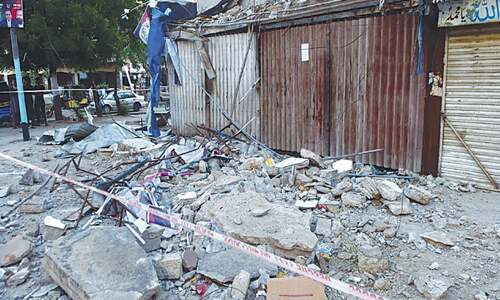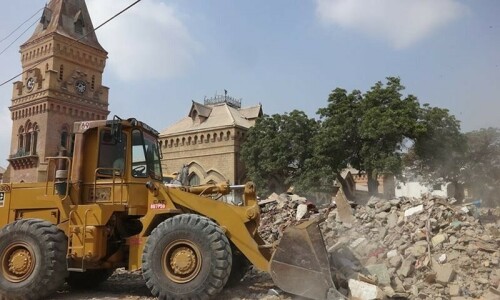HYDERABAD: The restoration work of the mausoleum of Mian Ghulam Shah Kalhoro (1757-1772 AD), a famous ruler of the Kalhoro dynasty, which had fallen into decay due to official neglect and vandalism in the shape of encroachments finally got under way under the aegis of the Endowment Fund Trust (EFT) for Preservation of the Heritage of Sindh.
The project costs Rs29.816 million and is scheduled to complete in June 2017.
The EFT, a non-profit organisation working for the preservation of heritage, organised on Friday evening a consultation meeting and an exposure visit of the site for the trustees of the EFT to have quality technical input from different experts on how to go about conservation of this monument and others like it across Sindh.
Besides trustees, some members of the audience also gave their suggestions for the preservation. The participants visited the mausoleum and took a keen interest in the golden inlay that was discovered during work in the interior arches of Kalhoro’s tomb.
Abdul Hamid Akhund, secretary of EFT, said the tomb’s roof caved in, as documented by Henry Cousens, a couple of years before 1896 and then in the colonial period, tiers and girders were used in place of dome.
“The archaeology department that used to be run by the federal government changed the facade of the mausoleum and plastered it the way it liked. The facade is 36ft high with 11ft of its top but the top has now been reduced to 5ft,” he said.
Elaborating, he said, the archaeology department replaced kashi tile work with plaster wherever the kashi tile was removed or fell for want of conservation.
Mr Akhund, who conducted proceedings of the programme, kept sharing information on EFT and the ruination of Sindh’s rich heritage whenever he came to the rostrum to invite a speaker or someone from the audience to share their observations.
He informed the audience that the EFT had recently completed work on the tomb of Mir Karam Ali Khan Talpur, a ruler of the Talpur dynasty, in Hirabad, Hyderabad. “This [Kalhoro’s] is a unique mausoleum from my point of view. We discovered golden inlay in painting’s pattern and calligraphy in one of the arches,” he said.
Dr Nafisa Shah, MNA and a trustee, deplored that heritage was faced with vandalism. “We need to expedite our movement for its preservation and conservation. Actually, we must rediscover culture of Sindh. I feel we have lost it somewhere,” she said.
“In fact we are collectively responsible for it. We have laws for the preservation of heritage but to no avail. If we need reforms in them then it should be done. Besides, we need to have a market for budding archaeologists and conservationists who want to pursue it as their career,” he said.
She appreciated EFT’s work going on in Khairpur and even in Jacobabad but stressed repeatedly the need for a drive for the preservation of heritage. “The outside world is not interested in our politics or law and order. It is this [heritage] that we can present to them. Therefore, we need to take this movement forward to protect it from cultural vandalism, real estate interests and commercial mindset,” said Dr Shah.
Jehangir Siddiqui, who runs a bank and is part of the EFT, said in a lighter vein that people tended to point out defects more than they came up with doable suggestions.
He recalled that when the trust was established it was decided to first have a catalogue of heritage sites. “Then we came to know we have 1,300 sites. It was then decided to prioritise the work. We have a resource of Rs1.4 billion and now we have to produce a five-year performance report as to what the EFT has so far done,” he remarked.
Marvi Mazhar, a heritage consultant, was quick to point out that students interested in the subject should be engaged and be given stipends. “We must have assistance of craftsmen and artisans,” she said, adding that the EFT should finalise a programme and she would offer her full cooperation to which Mr Akhund reminded her that any such a programme must be developed by her and the EFT would assist her fully. Durya Kazi of Karachi University’s arts and design department was disappointed to see stark difference in new and old buildings’ architecture. The builders and developers needed to focus on this architecture in their construction to keep future generation abreast of their past architecture and design, she said.
Prof Lal Jaskani of Sindh University said that Ghulam Shah Kalhoro was Shah Jehan of Sindh because of his love for marble and building magnificent edifices. “He was a visionary who was interested in raising majestic buildings,” he said.
The director of the Goethe Institut who was visibly impressed by the Islamic architecture said in his brief comments that his organisation was ready to offer support and work with the EFT on this project.
Dr Qasid Mallah said that he and his students were willing to work for the project which was all about conservation and said he believed in non-destructive technology while preserving a monument.
“We can come up with our proposals in a week’s time. Its digital and physical documentation should be done not only brick by brick but by each centimeter,” he said.
Former vice chancellor of Sindh University and EFT’s chairman of technical and finance committee Mazharul Haq Siddiqui described Ghulam Shah Kalhoro as benefactor of Sindhi culture.
“This treasure of antiquity encourages us to work for it for further betterment and preservation. The project is the beginning of a big work. In fact this journey is unending,” he said. Owner of a media house Ghulam Nabi Morai, Saeed Mangi of Sindhology, Shabnam Baloch, Mohammad Sajid Abbasi, a student, and others also shared their thoughts.
Published in Dawn, July 4th, 2015
On a mobile phone? Get the Dawn Mobile App: Apple Store | Google Play















































